Apple trees truly are giving trees. In spring, their fragrant, pale blossoms dot the landscape with a welcome, hopeful change from the soggy grays and browns of late winter. In summer, their lush foliage offers shade from the bright sun.
In fall, their juicy fruit is the stuff of the best memories—hay rides at the apple orchards, pies perfuming the oven, mulled cider warming frosty noses and thawing chilled fingers. And finally, in winter, the time comes for a homesteader to give some love back to their trees and prune them for the next growing season.
To put it simply, pruning is selectively and carefully cutting material from your trees in order to keep them healthy and/or create the desired shape. Pruning works with the tree’s “instincts” to spur it into structurally balanced growth, help it vigorously produce leaves and fruit, or heal damage more quickly.
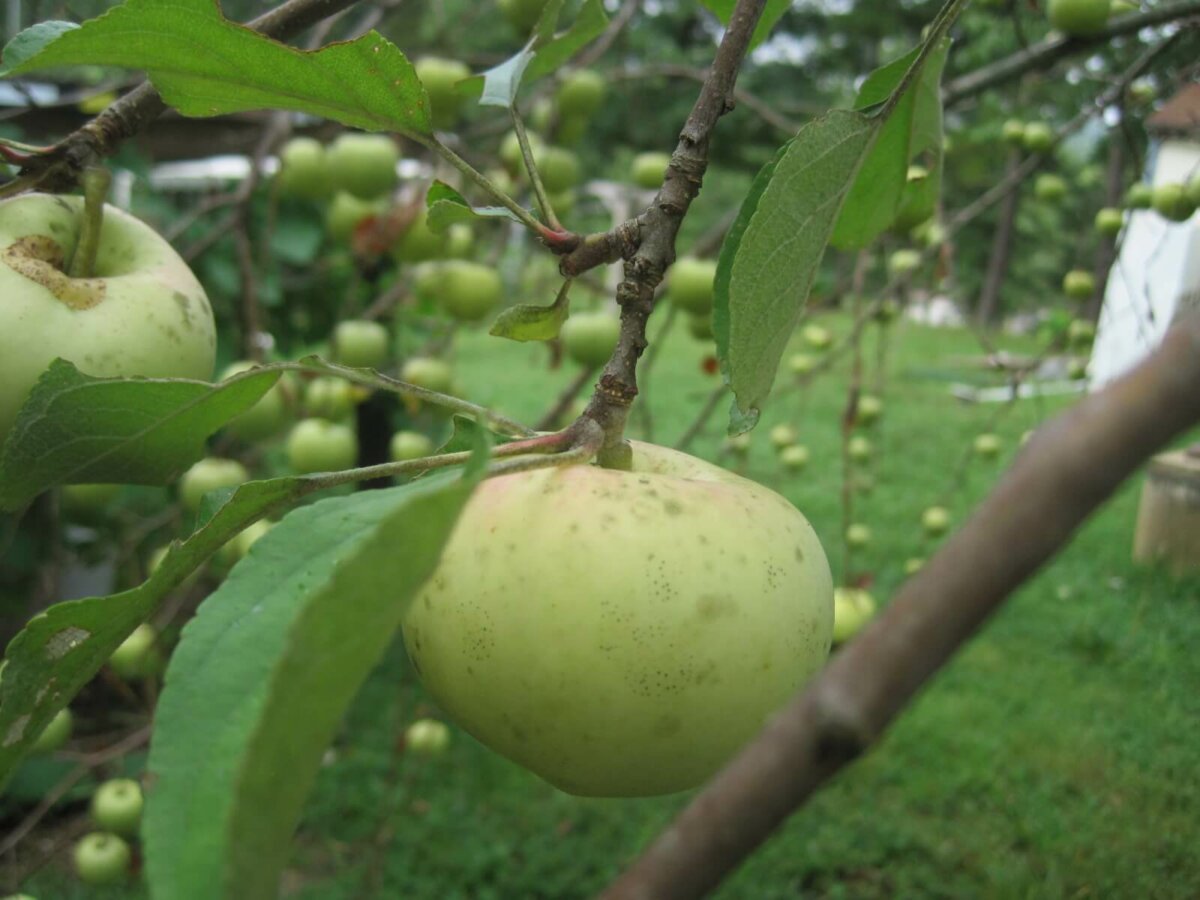
To the nervous, first-time pruner, loppers in hand, it may seem somewhat counter-intuitive to cut the branches off of a tree that you’re trying to help grow. But the first key to pruning is to think of apple trees in plant terms, not human terms.
Often, when a plant is damaged, it reacts by sealing off the wounded area with scar tissue, then pushing out new shoots below the wound. This trait allows the pruner to work with the plant to create everything from prize-winning large fruits to seahorse-shaped topiary.
Pruning is both a very basic skill and a highly developed world. We’ll keep to the backyard end of the spectrum in this article. If you are interested, however, Royal Horticultural Society’s book Pruning & Training, by Christopher Brickell and David Joyce, is a fascinating, well-photographed, and in-depth look at the fine art of training, shaping, and directing pretty much any plant.
Why Prune?
Quick Crop Blog sums it up nicely with these three reasons to prune an apple tree:
1. Establishing The Structure Of The Tree Makes It Easier To Maintain
A basic, easy-to-maintain form of an apple tree is the “bush” shape. If you have the opportunity to start from scratch with young trees, but are a novice when it comes to fruit tree management, this form will allow you to reach the majority of the fruit without a tall ladder. You’ll also have easy access for branch, bud, and flower management.
Just keep in mind—the low-growing bush shape can be an all-night buffet for deer! If you live in an area with a high population of ravenous white tails, the taller, old-fashioned “standard” shape for an apple tree will keep more of the fruit out of reach.
Maintaining the form of the apple tree is not purely aesthetic or ergonomic, however. A balanced, evenly branched tree is structurally more sound, providing your apple crop with the strong branches needed to hold it all up.
2. Removing Dead, Diseased Or Damaged Wood Keep The Tree Healthy
Trees are living things, and like any living thing, they sometimes get sick or hurt. Storms break branches, fungus infects broken bark, and insects infest holes.
Removal of problematic areas allows the tree to focus all its energy into creating blossoms, foliage, and of course, fruit.
Any bad branches left attached may sap the tree’s energy or allow disease to enter and kill off the whole tree.
3. Pruning Allows Sunlight To Access The Ripening Fruits
You may notice that on an unpruned apple tree the majority of the fruit is borne on the uppermost areas of the crown. Thinning out the branches of an apple tree brings all that fruiting potential back into arm’s reach!
How To Prune Apple Trees
When To Cut
Typically, the best time to prune an apple tree is in the winter, when the tree is totally dormant and ravenous bugs and fungal spores are at a minimum. You don’t want to prune it too early—if you cut branches while the tree is still active, you may stimulate the tree to put out new growth right as the cold weather is setting in.
Some of the fancier forms for apple trees, such as the espalier and cordon form, require summer pruning—research the “Lorette System” if you’re up for the challenge!
How To Cut
Four tools essential for pruning work are a sharp set of hand pruners (also called secauters), long-handled loppers, pruning saws, and a sharp knife. Each tool is ideal for a different thickness of twig and branch.
Secateurs should only be used with branches and twigs no thicker than a pencil. When you make these cuts, be sure to make sure you do not cut into or beneath the level of the leaf bud nearest your cut.
Loppers are best for bigger branches that still fit entirely within the “bite” of the blade.
Any bigger than that, and the pruning saw is your best option. These curved saws are ideal for green wood—their teeth don’t get all clogged up like a regular household saw might. For branch removal large enough to require a saw, cut off the bulk of the branch first to reduce the weight, then make the clean cut above the branch collar.
Clean up any cut that looks rough with the sharp knife. The cleanliness of each cut is crucial to the health of your tree. Think of yourself as a surgeon—just as with human skin, a clean slice heals much more quickly than a ragged, jagged cut.
And as you will see, part of making a clean cut is making sure you use the right tool for the job. If, for example, you find yourself tugging and wrestling with the secateurs to get through a branch, you’re trying to hack through too large a piece. Your cut will be ragged and will do more damage than good!
So, how do you know where to cut? Start with the branch collar—probably the most important part of a tree’s body to know.
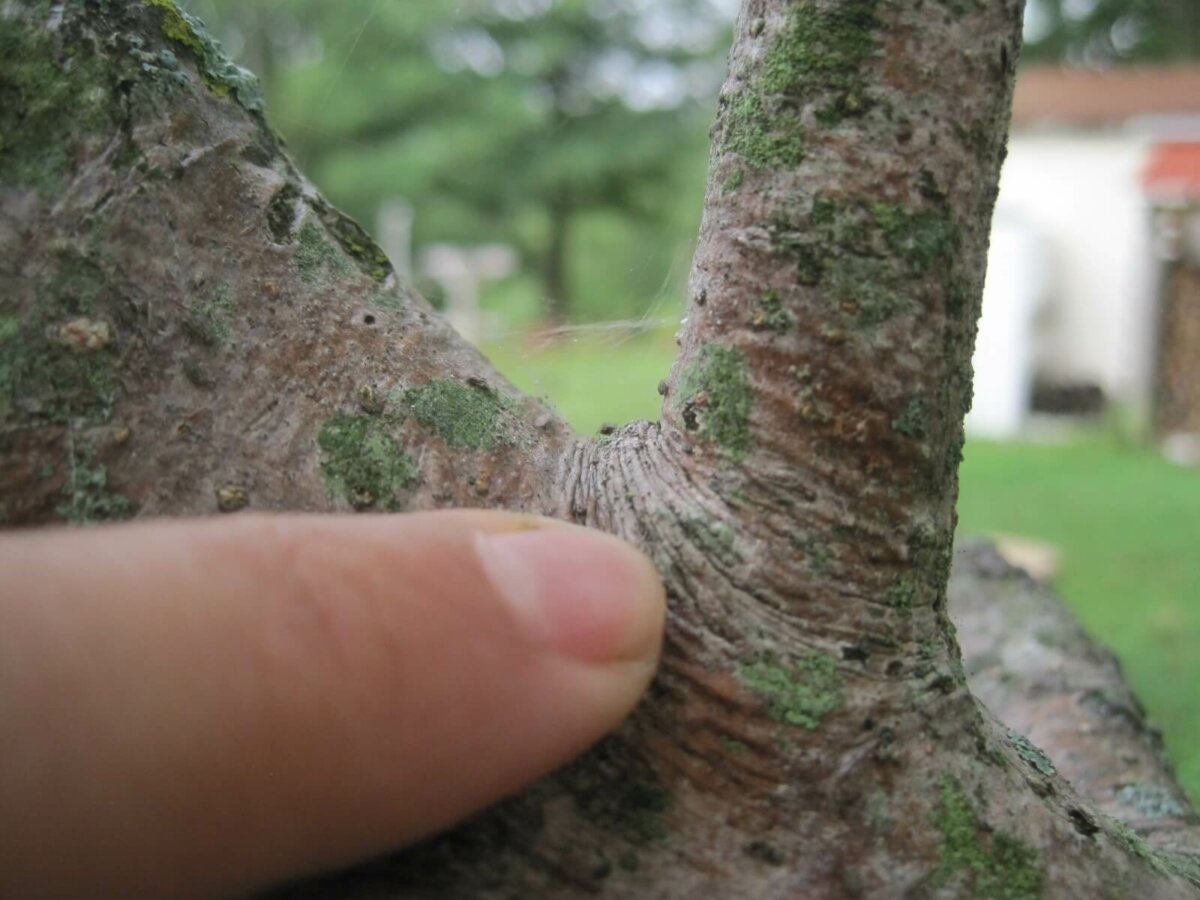
This grouping of cells at the base of a limb is the wood-generation powerhouse of the tree. It is situated close to the main trunk of the tree itself, often above the bark ridge—the place where branch and trunk merge.
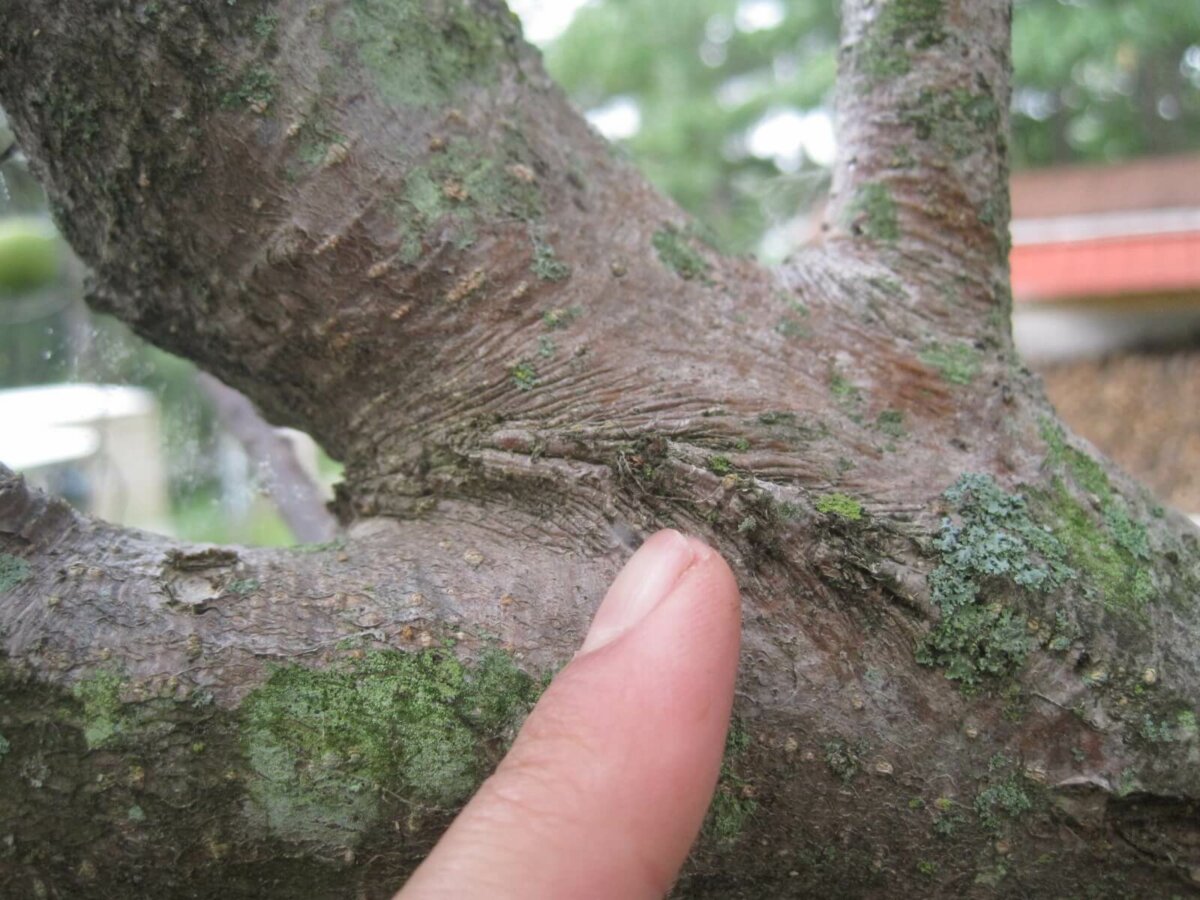
You never want to cut into either the branch collar or the bark ridge—this breaches the plant’s natural defenses against infection.
Related Post: Best Electric Pole Saw
You want to cut right above the branch collar, leaving no stub. If a stub is left, it will die jutting out, preventing the branch collar from closing over the wound and making a complete, healed scab.
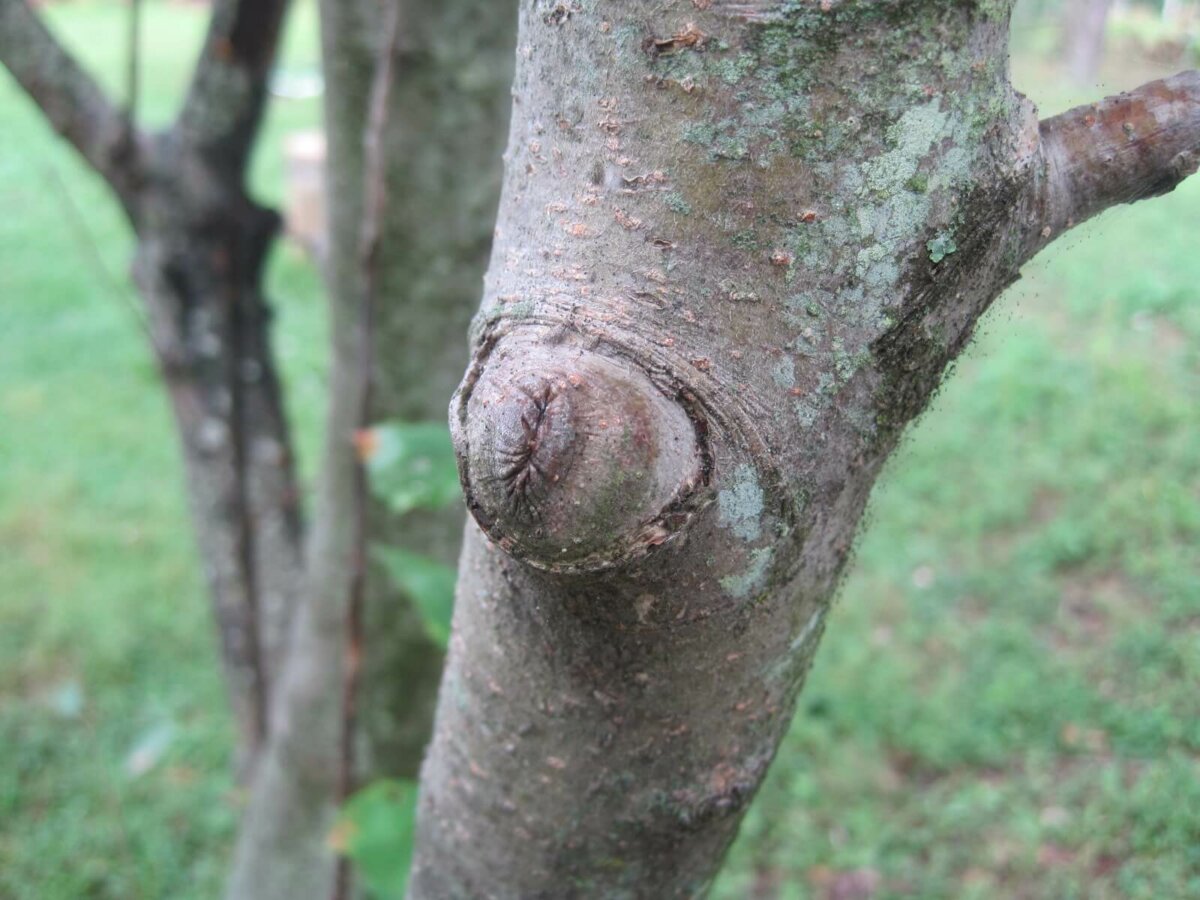
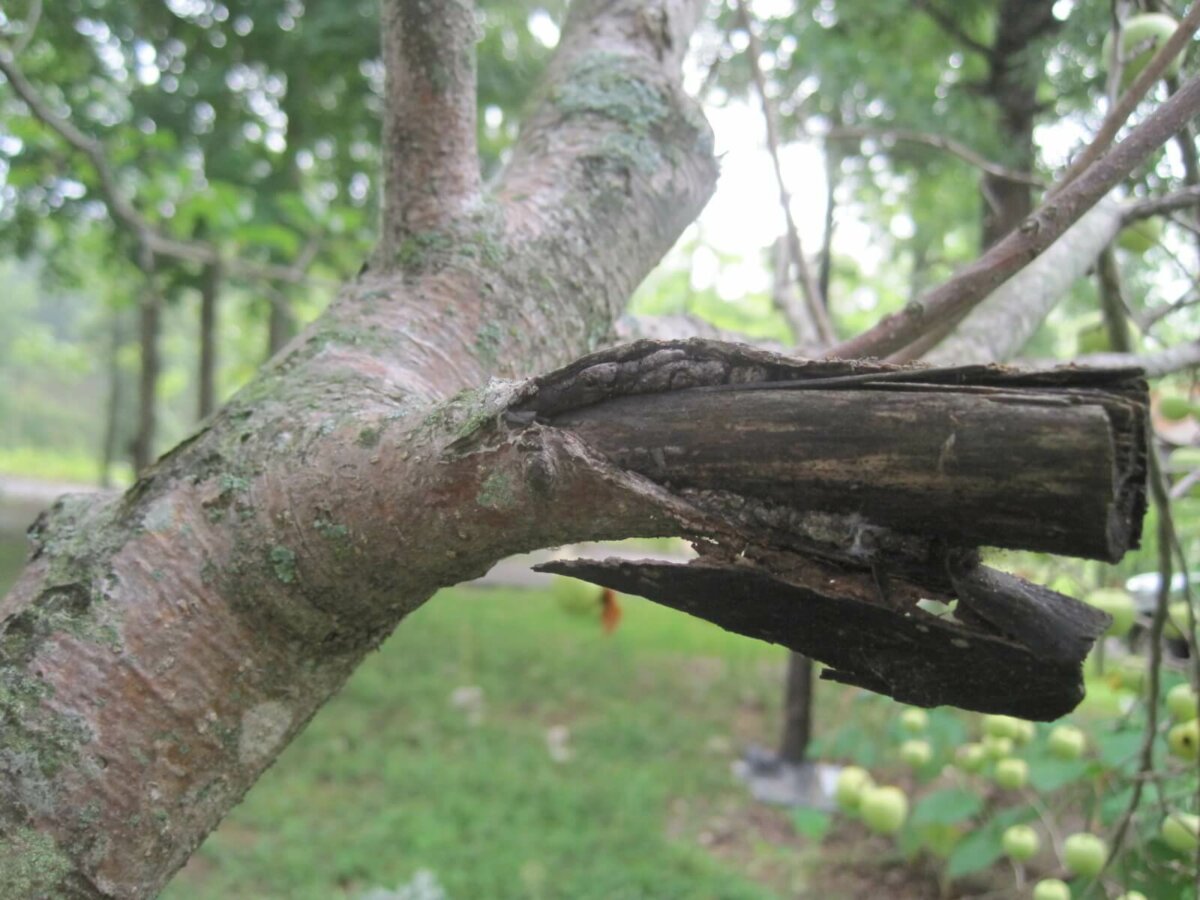
This branch above was pruned poorly, with the branch trimmed far away from the branch collar. The wound was never able to heal the stump—it was too long. As a result, the dead branch is rotting, allowing disease and decay to enter the living tissue.
What To Cut
If you, like many homesteaders, have inherited apple trees with your property, you may need to do some triage to salvage them from years of neglect. Resist the urge to go crazy with the pruners, though! Pruning any tree too hard will result in a profusion of weak, congested growth that may give you even more trouble to deal with.
Pruning is a multi-year exercise in patience. Do a little bit every year, giving your trees the chance to recover and become more healthy over time. A good rule of thumb is to not remove any more than a quarter of the tree’s crown every year and to focus on restoring health, not getting an immediate bumper crop.
No matter what form you want your trees to take, the first thing you need to prune off is any dead, damaged, or diseased growth.
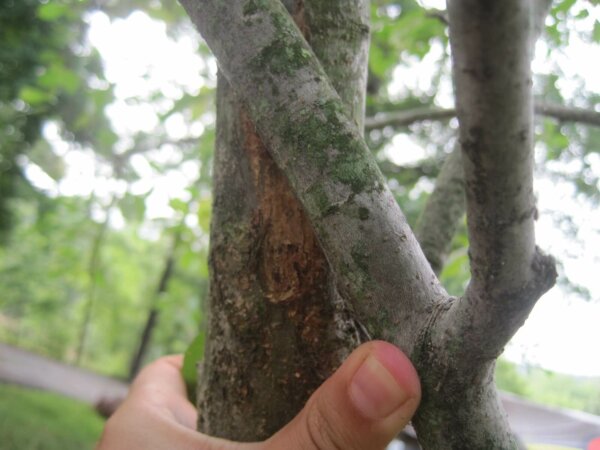
Then, take a good look up and down your tree and look for any branches that are crossed and rubbing against each other—you’ll want to retain the younger or healthier branch, if possible. Look at the base and remove any suckers—fast-growing shoots from the base that are only going to steal nutrition from the fruit.
Finally, look for congested areas where sunlight and air don’t have enough access to the branches. In Restoration Agriculture, Mark Shepard shares this unorthodox way to remember how much to prune: “Prune spaces between the branches so that a robin could fly through it and not touch its wings. But if you could throw a cat through it and it couldn’t catch a branch, then you cut too much.”
Thin out what you can, airing on the side of caution to make sure you don’t remove too much. Remember, pruning is a multi-year affair. The end result should be a balanced-looking, strongly branched tree that has plenty of room for sunlight and airflow. It may take a while to get what you want, but it’s worth it in the end.
What Happens If You Don’t Prune Your Trees
Some folks may choose to take a “hands-off” approach to their fruit trees, knowing that plants just want to make fruit, whether they are pruned or not. If you don’t prune your trees, there are risks and benefits. Apples are usually grown on the outermost parts of a branch, particularly where they receive ample sunlight. In a mature, unpruned tree, that area is often the upper crown of the tree—far out of reach.
I imagine that the benefit of a “naturally growing” tree is, first and foremost, the convenience of not having to maintain an artificial shape. Though the fancier forms—espaliers, cordons, fans, stepovers, and palmettes—are both beautiful and functional, they require a skilled hand and maintenance to stay healthy.
Even if you decide to go with a more easy-going approach to your trees—or if you inherited an older, unmaintained orchard—it is still a good idea to go over your trees a few times a year, especially after a storm. Removing dead or damaged branches help the tree put its energy into its good branches, resulting in more fruit and longer-lived trees.
Some Other Things To Consider
First, as obvious as it seems, ensure that the trees are in a sunny location. Apples are “full-sun” plants, so an eastern or northern- facing slope is ideal for ensuring they get at least 6 hours of sun a day. If they’re overshadowed by other taller trees or buildings, they’ll neither flourish nor produce much fruit.
Additionally, make sure they’re in well-drained soil. Trees that are waterlogged too long may die. At the same time, be sure to give them plenty of water—particularly newly planted trees. They’ll need it to develop a good root system.
Providing a thick layer of organic mulch will help keep your trees moist while also providing slow-release nutrients as the material decomposes. Just make sure to not mound the mulch directly against the bark of any tree—mice can nest in it over the winter, using the bark of your trees as a snack.
If you’ve pruned diseased material from your trees, be sure to pick up the pieces and burn them. If you compost them nearby, or if you leave them around the trees themselves, the infection can continue to spread back onto your trees.
Pruning is an accessible skill for any orchard-keeper, from the complete novice to the skilled tree-trainer. Do your future pies and cider a favor and keep those trees in healthy shape!
Related Post: What Is Fruit Tree Grafting?
Resources
- Pruning Apple Trees, Stark Bros
- How To Prune An Overgrown Apple Tree, The Spruce
- How To Prune Your Fruit Trees, Modern Farmer
- An Introduction To Pruning Apple Trees, Quickcrop Blog
- Fedco Trees Tips for Renovating Old Apple Trees, Fedco Seeds
- Pruning Apple Trees, Provident Living Today
- Training And Pruning Apple Trees, University Of Wisconsin Extension
- The 1-2-3 Rule Of Pruning, Good Fruit Grower
- Growing Apples, The Old Farmer’s Almanac










































That’s a thorough details and tips for pruning that is applicable not only for Apple trees but other fruit trees in general.
Thanks so much! I do hope it is helpful. And yes! Much of this information is totally applicable to pretty much any other fruiting tree–I just have the most experience with apple trees. 🙂
Thank you for talking about how it can seem not right to cut branches off a growing tree. I want to start my garden this summer actually. I will also find a good tree trimming service in my area.
Starting a garden sounds like a wonderful idea, and ensuring your trees are properly trimmed will definitely help them thrive. Best of luck with your gardening journey this summer!